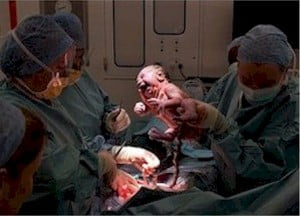Lying in my hospital bed after my second daughter was born, I felt sorry for my roommate who had just had her second baby surgically delivered by cesarean section. Although both of us had our first babies delivered by C-section (my older child was breech and couldn’t be safely turned), my roommate opted to have a repeat cesarean for her second child. In contrast, I took my doctor’s advice to have what is popularly called a VBAC (vaginal birth after cesarean) and was enjoying the relative luxury of taking care of a newborn baby without the sharp pains, tedious wound care and limited mobility from major abdominal surgery. My roommate’s frequent sighs and moans reminded me how even sitting up in bed after my cesarean had required a major strategic plan and how difficult it was to take a shower while tethered to an IV pole.
So I was surprised to learn that after I had my second child, the popularity of VBACs had taken a downward turn, despite the fact that most incisions used in cesareans were still low-transverse incisions (horizontal incisions below the belly button) that were less likely to cause uterine rupture during labor than the relatively archaic longitudinal incision.
By the late 1990s, many women were once again being told by their doctors, “Once a cesarean, always a cesarean,” and the rate of VBACs plummeted from 28% in 1996 to only 8.5% in 2006.
The reason for the dramatic plunge was the renewed concern about danger from uterine rupture, a complication that occurred in fewer than 1% of cases, yet was still thought by some doctors and hospitals to put the mother and child at unnecessary risk (not to mention their own higher risk of malpractice lawsuits).
VBACs Make Another Comeback
Twenty years later, the pendulum is swinging back toward VBACs again as many obstetricians attempt to make automatic repeat cesareans as obsolete as routine episiotomies. New guidelines from The American College of Obstetricians and Gynecologists (ACOG) released this week not only support the doctor group’s recommendations from earlier this decade that women with one previous cesarean delivery should be given the choice to have a VBAC. The new guidelines go a few steps further, suggesting that even women with two previous cesarean incisions, women expecting twins and women with an unknown type of uterine scar should consider having a TOLAC (trial of labor after cesarean).
Cesareans Not Without Risk Either
Many doctors and expectant parents believe the risk of uterine rupture from having a VBAC should be weighed against the risk of having a cesarean, the latter of which includes hemorrhaging; infection; bowel and bladder injury; blood transfusion; and possibly abnormal placenta conditions, such as placenta previa and placenta accreta.
The International Cesarean Awareness Network (ICAN) believes the risks of cesareans over VBACs are even greater than some so-called medical experts claim because of “selective use of the (medical) literature.” The advocacy group cites further risks to mothers and babies from cesarean deliveries, stating that women who have cesarean sections subsequently have higher rates of infertility, miscarriage and ectopic pregnancy and that from 2% to 6% of cesarean babies are cut by the surgeon’s scalpel (incidents which they believe are under-reported).
Parents’ Right to Choose
From my own personal experience, going through labor after a previous cesarean delivery is no picnic. Maybe that’s why it’s called labor and not a Hawaiian vacation. Still, once my baby was born I was able to bounce back quickly and devote my full attention to her instead of my own recovery.
After my first child was delivered by cesarean, I remember wondering, Who else has surgery on the first day of their new job? (in my case, being the primary caregiver of a totally dependent infant). While I was glad to have a cesarean with my first child, whose health would have otherwise been at risk, I was grateful that I was given a choice not to have a cesarean with my second child, and I am encouraged that obstetricians are once again stepping up to give the next generations of mothers and fathers that same choice.
Sources:
http://www.acog.org/from_home/publications/press_releases/nr07-21-10-1.cfm
http://www.ican-online.org/vbac/postion-statement-elective-cesareans-riskier-than-vaginal-birth



